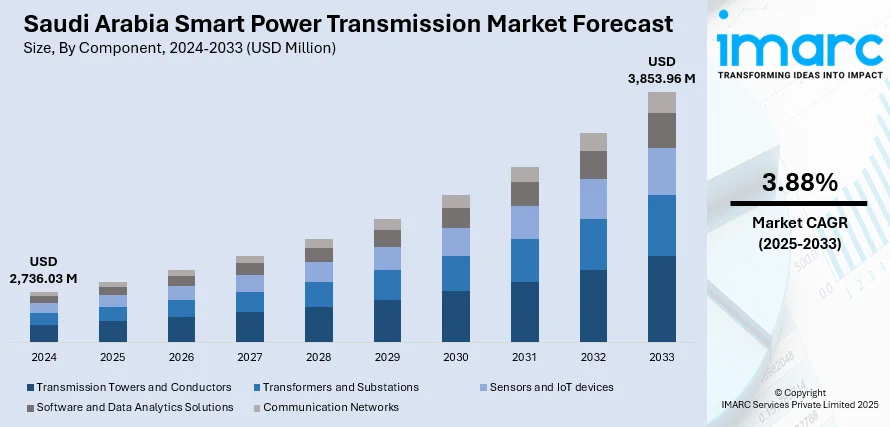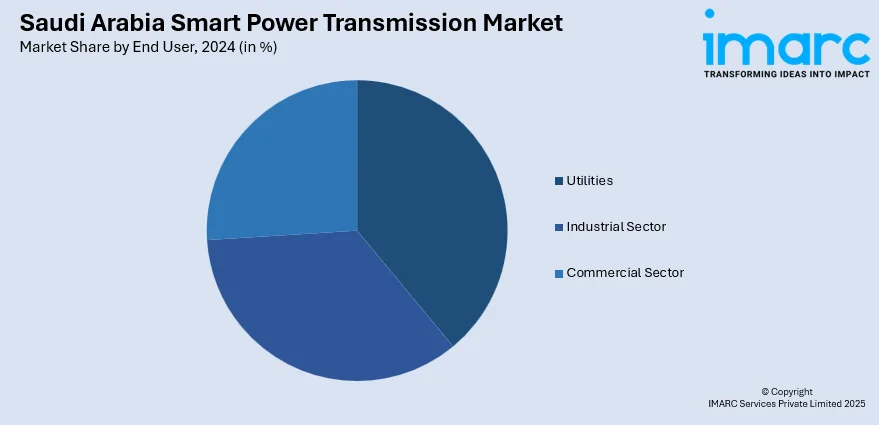
Saudi Arabia Smart Power Transmission Market Size, Share, Trends and Forecast by Component, Technology, Voltage Level, End User and Region, 2025-2033
Saudi Arabia Smart Power Transmission Market Overview:
The Saudi Arabia smart power transmission market size reached USD 2,736.03 Million in 2024. Looking forward, IMARC Group expects the market to reach USD 3,853.96 Million by 2033, exhibiting a growth rate (CAGR) of 3.88% during 2025-2033. The market is undergoing rapid growth owing to the role of the Vision 2030 program in spurring development and diversifying the energy matrix. Smart grid technologies, including advanced metering infrastructure and real-time monitoring systems, integration of renewable energy and rising demand for power as a result of urbanization and industrialization also necessitates strong and smart transmission networks, which is further increasing the Saudi Arabia smart power transmission market share.
|
Report Attribute
|
Key Statistics
|
|---|---|
|
Base Year
|
2024 |
|
Forecast Years
|
2025-2033
|
|
Historical Years
|
2019-2024
|
| Market Size in 2024 | USD 2,736.03 Million |
| Market Forecast in 2033 | USD 3,853.96 Million |
| Market Growth Rate 2025-2033 | 3.88% |
Saudi Arabia Smart Power Transmission Market Trends:
Integration of Renewable Energy Sources
Saudi Arabia's drive to diversify its energy mix is driving the integration of renewable energy sources into its power transmission grid. The country's Vision 2030 program focuses on decreasing dependence on fossil fuels and raising the proportion of renewables, especially solar and wind power. This shift requires the power grid to be modernized to handle the intermittent nature of renewable energy. Intelligent power transmission systems with advanced sensors and real-time monitoring functions are necessary for the management of intermittency and distributed generation with renewable sources. Through improved grid flexibility and responsiveness, these systems provide a stable and reliable supply of electricity even as the energy mix changes. Renewable energy integration ensures environmental sustainability and also aligns with international trends towards cleaner energy solutions. With Saudi Arabia continuing to invest in renewable energy projects, the growth of smart power transmission infrastructure is still a vital part of its energy strategy. Recently, ABB announced that it is collaborating with The Red Sea Development Company (TRSDC) to provide power systems and digital solutions that will ensure the resort operates on 100% renewable energy upon its completion in 2030. Moreover, ABB's digital platform Ability Energy and Asset Manager will deliver real-time insights into system performance, aiding in the reduction of costs and risks while enhancing performance and safety throughout the whole operation. Through data monitoring and implementing corrective measures, the solution can minimize unplanned downtime to guarantee an uninterrupted power supply and achieve savings of up to 45% on operating costs.

Smart Grid Technology Advances
The use of smart grid technologies is influencing the Saudi Arabia smart power transmission market growth. These technologies leverage digital communication, automation, and data analytics to make the power grid more efficient and reliable. Some of the significant components include advanced metering infrastructure (AMI), automated substations, and distribution automation systems. By enabling real-time monitoring and control, smart grids facilitate predictive maintenance, reduce operational costs, and improve fault detection and response times. Furthermore, the integration of artificial intelligence (AI) and machine learning (ML) algorithms facilitates dynamic load balancing and optimization of power flow, ensuring that electricity is delivered where and when it is needed most. These advancements, in addition to enhancing the operational efficiency of the power transmission network, also enhance the general resilience and sustainability of the energy infrastructure.
Diversification of Energy Sources
Saudi Arabia is currently building its power transmission infrastructure to increase regional cooperation and energy security. Building cross-border interconnections with surrounding countries, for example, the Saudi-Egypt power interconnection project, enables the trade of electricity and assists grid stability within the region. These interconnections allow Saudi Arabia to export and import electricity, better balancing demand and supply, and lowering the threat of power shortages. Moreover, regional coordination in power transmission infrastructure fosters economic integration and advances the overall objectives of the Gulf Cooperation Council (GCC) towards the establishment of a unified energy market. Grid interconnections enlargement also provides opportunities for sharing renewable energy resources, maximizing the use of clean energy across borders. As Saudi Arabia keeps investing in regional energy infrastructure, the construction of strong and integrated power transmission networks will be vital in ensuring a sustainable and reliable energy future for the region.
Saudi Arabia Smart Power Transmission Market Segmentation:
IMARC Group provides an analysis of the key trends in each segment of the market, along with forecasts at the country and regional levels for 2025-2033. Our report has categorized the market based on component, technology, voltage level, and end user.
Component Insights:
- Transmission Towers and Conductors
- Transformers and Substations
- Sensors and IoT devices
- Software and Data Analytics Solutions
- Communication Networks
The report has provided a detailed breakup and analysis of the market based on the component. This includes transmission towers and conductors, transformers and substations, sensors and IoT devices, software and data analytics solutions, and communication networks.
Technology Insights:
- Supervisory Control and Data Acquisition (SCADA) Systems
- Phasor Measurement Units (PMUs)
- Flexible AC Transmission Systems (FACTS)
- Advanced Metering Infrastructure (AMI)
- Smart Transformers
- High Voltage Direct Current (HVDC) Transmission
- Wide-Area Monitoring Systems (WAMS)
A detailed breakup and analysis of the market based on technology has also been provided in the report. This includes supervisory control and data acquisition (SCADA) systems, phasor measurement units (PMUs), flexible AC transmission systems (FACTS), advanced metering infrastructure (AMI), smart transformers, high voltage direct current (HVDC) transmission, and wide-area monitoring systems (WAMS).
Voltage Level Insights:
- Extra High Voltage (EHV) Transmission (≥ 220 kV)
- High Voltage (HV) Transmission (66 kV - 220 kV)
- Medium Voltage (MV) Transmission (11 kV - 66 kV)
A detailed breakup and analysis of the market based on the voltage level has also been provided in the report. This includes extra high voltage (EHV) transmission (≥ 220 kV), high voltage (HV) transmission (66 kV - 220 kV), and medium voltage (MV) transmission (11 kV - 66 kV).
End User Insights:

- Utilities
- Industrial Sector
- Commercial Sector
The report has provided a detailed breakup and analysis of the market based on the end user. This includes utilities, industrial sector, and commercial sector.
Regional Insights:
- Northern and Central Region
- Western Region
- Eastern Region
- Southern Region
The report has also provided a comprehensive analysis of all the major regional markets, which include Northern and Central Region, Western Region, Eastern Region, and Southern Region.
Competitive Landscape:
The market research report has also provided a comprehensive analysis of the competitive landscape. Competitive analysis such as market structure, key player positioning, top winning strategies, competitive dashboard, and company evaluation quadrant has been covered in the report. Also, detailed profiles of all major companies have been provided.
Saudi Arabia Smart Power Transmission Market Report Coverage:
| Report Features | Details |
|---|---|
| Base Year of the Analysis | 2024 |
| Historical Period | 2019-2024 |
| Forecast Period | 2025-2033 |
| Units | Million USD |
| Scope of the Report | Exploration of Historical Trends and Market Outlook, Industry Catalysts and Challenges, Segment-Wise Historical and Future Market Assessment:
|
| Components Covered | Transmission Towers and Conductors, Transformers and Substations, Sensors and IoT devices, Software and Data Analytics Solutions, Communication Networks |
| Technologies Covered | Supervisory Control and Data Acquisition (SCADA) Systems, Phasor Measurement Units (PMUs), Flexible AC Transmission Systems (FACTS), Advanced Metering Infrastructure (AMI), Smart Transformers, High Voltage Direct Current (HVDC) Transmission, Wide-Area Monitoring Systems (WAMS) |
| Voltage Levels Covered | Extra High Voltage (EHV) Transmission (≥ 220 kV), High Voltage (HV) Transmission (66 kV - 220 kV), Medium Voltage (MV) Transmission (11 kV - 66 kV) |
| End Users Covered | Utilities, Industrial Sector, Commercial Sector |
| Regions Covered | Northern and Central Region, Western Region, Eastern Region, Southern Region |
| Customization Scope | 10% Free Customization |
| Post-Sale Analyst Support | 10-12 Weeks |
| Delivery Format | PDF and Excel through Email (We can also provide the editable version of the report in PPT/Word format on special request) |
Key Questions Answered in This Report:
- How has the Saudi Arabia smart power transmission market performed so far and how will it perform in the coming years?
- What is the breakup of the Saudi Arabia smart power transmission market on the basis of component?
- What is the breakup of the Saudi Arabia smart power transmission market on the basis of technology?
- What is the breakup of the Saudi Arabia smart power transmission market on the basis of voltage level?
- What is the breakup of the Saudi Arabia smart power transmission market on the basis of end user?
- What is the breakup of the Saudi Arabia smart power transmission market on the basis of region?
- What are the various stages in the value chain of the Saudi Arabia smart power transmission market?
- What are the key driving factors and challenges in the Saudi Arabia smart power transmission market?
- What is the structure of the Saudi Arabia smart power transmission market and who are the key players?
- What is the degree of competition in the Saudi Arabia smart power transmission market?
Key Benefits for Stakeholders:
- IMARC’s industry report offers a comprehensive quantitative analysis of various market segments, historical and current market trends, market forecasts, and dynamics of the Saudi Arabia smart power transmission market from 2019-2033.
- The research report provides the latest information on the market drivers, challenges, and opportunities in the Saudi Arabia smart power transmission market.
- Porter's five forces analysis assist stakeholders in assessing the impact of new entrants, competitive rivalry, supplier power, buyer power, and the threat of substitution. It helps stakeholders to analyze the level of competition within the Saudi Arabia smart power transmission industry and its attractiveness.
- Competitive landscape allows stakeholders to understand their competitive environment and provides an insight into the current positions of key players in the market.
Need more help?
- Speak to our experienced analysts for insights on the current market scenarios.
- Include additional segments and countries to customize the report as per your requirement.
- Gain an unparalleled competitive advantage in your domain by understanding how to utilize the report and positively impacting your operations and revenue.
- For further assistance, please connect with our analysts.
 Request Customization
Request Customization
 Speak to an Analyst
Speak to an Analyst
 Request Brochure
Request Brochure
 Inquire Before Buying
Inquire Before Buying




.webp)




.webp)












